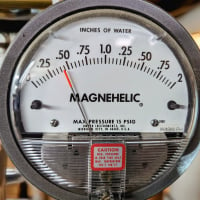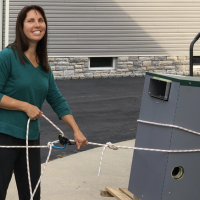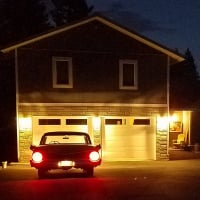I hate my steam risers

Comments
-
Probably not a good idea to mess with a pipe in a building you do not own.
Depending on the system design, you could ask management to do a little repiping. That vent at the top can be below the floor in most cases. You definitely do not need a 8' pipe for that vent. Perhaps a 8" pipe would work. I wonder if someone read the instructions wrong and put a 8 foot pipe where a 8 inch pipe was all that was required?Edward Young Retired
After you make that expensive repair and you still have the same problem, What will you check next?
0 -
-
Kind of silly way to pipe that. I'd use two 45 degree elbows to offset it against the wall tight against the window casing if you wanted to retain the heat from it. Or cut it off low, as suggested. Moving or shortening it shouldn't affect the radiator. But, as Ed said, it's really not yours to mess with.1
-
Hi, it’s me. I’m the management. It’s a small building of which I am the president and no one else has any idea what’s going on. if I cut it off closer to the floor is there a specific valve you recommend? My contractor installed the ones currently on because the previous owner had them glued shut. Does anyone on this thread work in Brooklyn?0
-
I'm sure someone else will comment regarding the height of that riser...VRA said:Hi, it’s me. I’m the management. It’s a small building of which I am the president and no one else has any idea what’s going on. if I cut it off closer to the floor is there a specific valve you recommend? My contractor installed the ones currently on because the previous owner had them glued shut. Does anyone on this thread work in Brooklyn?
But if you have hissing going on it's because you're either holding air back and not letting steam get to the radiators fast enough, or, you're creating an excess amount of steam and building unnecessary pressure. Both mean you're burning money for no reason and unintentionally annoying tenants.
Both can be fixed, one easier than the other.
When you have time, can you share some pictures of the radiator vents, the riser vents, the main vents and the boiler and it's piping?
Single pipe 392sqft system with an EG-40 rated for 325sqft and it's silent and balanced at all times.
2 -
I agree with @ChrisJ. I will also elaborate. By your description, none of the problems you describe will be fixed by shortening the riser, other than the window blocking issue. Expansion noise will still exist as shortening will not adjust, nor remove any of the parts making noise. The hissing is excess pressure, inadequate venting, oversized boiler, bad piping, any number of things that don't exist at the riser, but may exist at the boiler. If the boiler is oversized you can keep pressure down with a vaporstat, but that is mainly a band aid for an oversized boiler building excess pressure.
I full appreciate someone moved it to a ridiculous location at some point, but that is honestly a separate issue from the other you present.
I'm not sure if @JohnNY does Brooklyn or not, I tagged him for comment.2 -
@VRA if you could show us a picture of your boiler controls and the other vents in the basement, odds are we could make recommendations to quiet the system and save you fuel. I don't see a problem with that pipe being shortened closer to the floor. That looks like a Gorton No.1 vent to me and a Gorton No.2 may be quieter, however it is best to address boiler settings and the main vents in the basement first to see the effects before replacing anything else.0
-
-
-
I would visit the apartment directly below. If there is no radiator connected to that riser then the riser is the heat source for all the apartments below you. In NYC, this was often done in bathrooms and kitchens because there was no room for radiators in those tiny spaces. If that riser is indeed the heat source for the apartments below then that air vent atop the pipe is serving the whole riser. Without it, there will be no heat.
See if you can check the apartment below for a radiator. That will help us help you. Thanks.Retired and loving it.3 -
*VRA, The system must be seen as a whole to properly modify piping. Sometimes what's done 'over here,' affects what's happening 'over there.'VRA said:Hi, it’s me. I’m the management. It’s a small building of which I am the president and no one else has any idea what’s going on. if I cut it off closer to the floor is there a specific valve you recommend? My contractor installed the ones currently on because the previous owner had them glued shut. Does anyone on this thread work in Brooklyn?
This may have once been a down-feed steam supply, and someone decided to up-feed. This steam main cum vent standpipe would then if so be intended to quick-vent the riser - which it's doing in any "e-vent", but to build this new intentionally would be a bit goofy.
Diagnostics requires compiling the facts, and a system overview with photos is the place to begin. Any system history is of value.
automaticsteam@yahoo.com - Bill*1 -
In my small Brooklyn building, one of the rooms on each side of the building, the room furthest from the boiler, has two risers. One is inside the wall and feeds the radiators; the other is exposed. They are fed separately from the cellar mains. I believe the purpose was to provide additional heat to that room. I can't say why a single riser with larger radiators wasn't the solution, but I think the condition is original.
I thought the only reason for noisy air valves is a defect in the valve. We recently had all the building's air valves replaced with Heat-Timer Varivalves. They are completely silent. At various times, the older valves would hiss, indicating they had worn out or were defective in some way. Replacing them with a new valve would solve the problem, unless the new valve was defective, which seems to be a problem sometimes with even new valves.1 -
After looking again at the picture, another thought occurred to me. If the steam system was installed after your building was built, which is possible if the building dates from the 1880s or 90s or older, it would have been far easier to have all the risers exposed rather than built into the walls. Perhaps the placement of the riser was just for convenience of installation and there is no separate riser to feed the radiators. The system in my building (1909) was part of the original construction.0
-
I am a homeowner originally from Northern California who has lived in Westchester County, NY for the past ten years. My trades background stems from earning a college degree in Automotive Technology from a college in my home state and working in that trade for a couple of decades. I joined this site to learn more about boiler based heating systems and the interesting history often presented here.
My automotive trained eye leads me to believe the radiator was added at some point after the riser was installed in the room, as shown in the photograph. While I have seen some dumb installs in the automotive world and the previous two MCM houses I have owned over the years. I have a hard time believing that a skilled tradesman would choose to install large diameter threaded iron pipe in the manner done to fit the radiator if they had any other choice. The supply pipe with valve coming out of the floor at an angle is the give away for me.
The other thing that caught my eye in the photo is the curious location of an apparent grounded 20 amp electrical circuit, as indicated by a single NEMA 5-20R 20 amp. 125V outlet. Why that type of outlet and why there?
0 -
-
Clearly, neither Frank Gerety (nor John Schultz) was ever in this room.

I know the OP wants to solve the noise problem. Fortunately, there are HH folks who are close enough to make a housecall, and it's not crazy to think that it might be remedied without needing to look under the floorboards. If it does come to that, however, whoever it is who does take on the project, please post some pictures of what you find. It sure looks to me like the radiator was piped *around* the riser, which would mean the riser was already in the way, albeit perhaps not as tall. There are a dozen (less wonky) ways to have done this. Also, the angle that the supply pipe comes out of the floor tells me there something "interesting" (shall we say) going on. Does the supply actually come from somewhere out of frame on the right? I don't want to derail this thread at the expense of the OP getting the problem resolved. I just want to state (or celebrate) the obvious: atypical scenarios like this on HH are so great--apart from the suffering of the resident, of course--because they give us all an opportunity to share how we approach "what you can't see" (without pulling up a floor or opening a wall) based on "what you *can* see", especially when it's something you've never seen before.
Fast. Cheap. Good.
Pick any two.1 -
The riser pipe was likely added before the radiators. At one point, NYC required central heating to replace stand-alone gasoline wall heaters. In some taxpayer buildings, landlords just installed bare pipe risers to satisfy the requirement. This building likely predates 1900, as told by the pressed window molding.
1 -
^^^THIS^^^ ..
Where did the heat come from before they put these risers in?
Did they have to put in their own steam source or did the City run the District Steam?
I think her riser is in front of the window because when they installed the system they started on the 1st floor to the side of the window but by the time they were going through the 3rd floor ceiling they realized the building had settled and wasn't plumb and that's where it ended up...
They did better with the riser for the radiator..One way to get familiar something you know nothing about is to ask a really smart person a really stupid question1 -
-
Yep...you just don't know.... a well-meaning bldg super or shoemaker plumber could have left his mark? Its not often, but I very rarely see plumbing and heating from 80-120 years ago that was shoddily put in, but there were a few hacks running around with a lead pot and Stillsons. This is most evident on Bell & Spigot Cast Iron soil pipe with poured lead joints that were hastily slapped together crooked, skewed and cocked at strange angles. I just saw this. Picture is in my phone Ill try to post it. Mad Dog1
-
There are also pressure and standing water issues that can cause the valves to make a lot of noise.JWoodoff said:
I thought the only reason for noisy air valves is a defect in the valve. We recently had all the building's air valves replaced with Heat-Timer Varivalves. They are completely silent.
This is the first time I've heard anyone use "silent" as a descriptor when discussing Vari-Valves. Typically, people say they work well but are loud. I'm glad you are having a different experience. You must be running at very low pressure.
Contact John "JohnNY" Cataneo, NYC Master Plumber, Lic 1784
Consulting & Troubleshooting
Heating in NYC or NJ.
Classes1 -
Could be used for a flag pole or a stop sign. May have to move the window.
Well, that's apartment living.
If management will allow access to the boiler room and other apartments, and pictures can be had, options can be considered. Or not.0 -
I had a large brownstone in Brooklyn and for the top (5th) floor, I replaced the valves with a T with the downstream side set up with vents and the upstream side set up to a new straight valve to the radiator. This was to evacuate the risers faster and would still work if I shut of a radiator. Find out if the riser feeds your radiator and you can to something like that. Tell the landlord that it would help to heat the building. I would NOT do anything yourself. Ask the landlord to do it.0
-
too bad it's not over in the corner....EdTheHeaterMan said:Probably not a good idea to mess with a pipe in a building you do not own.
Depending on the system design, you could ask management to do a little repiping. That vent at the top can be below the floor in most cases. You definitely do not need a 8' pipe for that vent. Perhaps a 8" pipe would work. I wonder if someone read the instructions wrong and put a 8 foot pipe where a 8 inch pipe was all that was required?1 -
35 years butchering wood (among other things) and I've never heard "pressed window molding. Cast plaster? I see the egg and dart....but the dark streak might be flaked paint?Long Beach Ed said:The riser pipe was likely added before the radiators. At one point, NYC required central heating to replace stand-alone gasoline wall heaters. In some taxpayer buildings, landlords just installed bare pipe risers to satisfy the requirement. This building likely predates 1900, as told by the pressed window molding.
I sure hope that picture was taken at night!1 -
35 years butchering wood (among other things) and I've never heard "pressed window molding.The design is pressed into a soft wood like poplar or "white wood" as it was called between a set of rollers. It's still made today. Cheap alternative to carving and not as detailed. The plaster stuff was "compo" and is still made today too. This is either one but window casing was usually pressed wood. It was cheapest.2
-
VRA, Did you find a solution? If not, here are my 2 cents. The top-of-riser air vent on single-pipe steam risers does not need to be at ceiling level. The riser can be cut off 12" above the floor and capped with a nipple to install a quieter riser vent such as a Hoffman 4A. I agree with the person who recommended the Heat Timer adjustable air vent for the radiator. The next part of the investigation is to find out the steam pressure settings for the boiler. This system was designed to distribute steam at 1 pound or less, but many boilers are set up initially at 5 pounds. James Blum PE2
-
hi. This isn’t resolved and now that winter is back I’m super annoyed again. Attaching pictures.
The building each unit has heat from the risers and each riser has a radiator associated. Some of the floor plans differ so maybe the radiators are angled differently to accommodate the space but none the less the radiators are each beside a riser. each unit of the 4 units is about 1600 sq feet and the building has a total of 4 risers. Each unit is one floor for a total of 4 floors above ground floors with the boiler in the basement.
Notably the hissing is WAY worse in the morning bc the thermostat increases from 68 to 72 degrees at 7am. It seems as though that drastic of an increase is leading to significantly more pressure than the usual heat click ons.
I have reached out to JohnNy but if anyone else is in the park slope area please reach out! 347-989-6464 Veronica
0 -
-
-
thank you! I’ll try it :)
0 -
That is a crazy arrangement!
My guess is the steam riser was put in after the building was built. The radiators were added later because the riser itself did not provide enough heat. But that is only a guess. I'm not an expert on steam heat, or, the history of your building.
Lowering the pressure might help. Replacing that air vent might also help. Both can be easily undone.
But that still leaves the riser sticking up in front of your window. Likely it can't just be cut off and caped. It needs to be vented. And that will required threads. I sure it can be done. I think I'd leave the riser as part of the history of your building.
0 -
-
Yep. I've put in a few for long term tenants.
Trying to squeeze the best out of a Weil-McLain JB-5 running a 1912 1 pipe system.0
Categories
- All Categories
- 87.3K THE MAIN WALL
- 3.2K A-C, Heat Pumps & Refrigeration
- 61 Biomass
- 429 Carbon Monoxide Awareness
- 120 Chimneys & Flues
- 2.1K Domestic Hot Water
- 5.8K Gas Heating
- 115 Geothermal
- 166 Indoor-Air Quality
- 3.7K Oil Heating
- 77 Pipe Deterioration
- 1K Plumbing
- 6.5K Radiant Heating
- 395 Solar
- 15.7K Strictly Steam
- 3.4K Thermostats and Controls
- 56 Water Quality
- 51 Industry Classes
- 50 Job Opportunities
- 18 Recall Announcements



















